Sheflera - leaves are falling
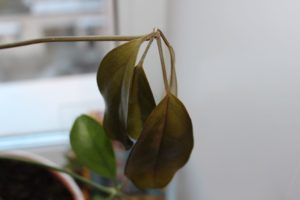
Sheflera is an ornamental plant belonging to the Araliev family. The beautiful large leaves of the cheflera grow from one point, like rays or knitting needles, due to which the plant has acquired a second name - "umbrella tree".
Sheflera does not need special care, she is quite unpretentious. But if the conditions of detention are not observed, the leaves fall off the chefs. Flower lovers who have an evergreen bush in their collection will find it useful to know why the cheflera sheds leaves.
Conditions of detention for chefs
In order to find out why the leaves of the cheflera are falling, and what to do if this phenomenon is observed, you should figure out what conditions of detention are especially comfortable for the ornamental plant.
Shefflers are home to the humid warm tropics, so the house plant also needs a fairly bright diffused light.
The plant needs moderate watering, and the air humidity is high, in this regard, the leaves should be regularly sprayed.
Leaves fall from chefs - reasons
- Sheflera throws off the leaves if the temperature is not observed. Moreover, both excessively high and low air temperatures are unfavorable for the plant. If the leaves of the cheflers darken and fall, and the trunk is still alive, then the flower can be saved by transplanting.
For this, dry branches are cut (it is advisable to sprinkle the cuts with crushed coal or treat with aniline paints, for example, brilliant green). Then the plant is transplanted into a new pot by transshipment, without disturbing the root system. For planting, a nutritious soil mixture is used. The transplanted shefler is placed in a well-lit, warm enough place.
- If the cheflera not only loses leaves, but her roots are rotten, then this indicates excessive watering, especially at low air temperatures. The plant can be reanimated by removing the rotten roots and keeping it in a solution of zircon or epin for 2 hours. Next, the roots are treated with a fungicide, and the flower is planted in a pot.
The chefler's bush is sprayed with a solution of epin (zircon) and wrapped in polyethylene for 2 - 3 days, which should be removed from time to time for ventilation. After recovery, it is necessary to adjust the watering, moistening the soil only if it is already dry.
- Often, the leaves of the cheflera turn black and fall off due to insufficient air humidity.
It is recommended to spray the flower with a spray bottle several times a week, and daily in summer. Also, the plant should be kept away from heating radiators.
- Drafts are destructive for sheflers, from which the edges of the leaves become brown and brittle. It is necessary to choose a place for keeping a houseplant away from the influence of air currents.
- The appearance of spots on the leaves may be due to insufficient soil aeration. The soil in which the chefler grows should always be loose.
- Often the reason for the loss of the decorative qualities of a plant is the defeat of the cheflera by pests: thrips, scabbard, spider mite.
In this case, the leaves curl and fall off, the growth of the flower slows down and, if the parasites are not destroyed, it dies. The damaged plant must be temporarily isolated from other indoor flowers. Pests should be removed with a soft cloth dipped in an aqueous solution of laundry soap.
In case of severe infection, you can treat the plant with karbofos or actellik at the rate of 20 drops per liter of water.
| Why do the buds of an orchid wither?
The beautiful orchid is prized for its unusually beautiful long flowering, which flower growers are eagerly awaiting. The buds are about to bloom, but suddenly you can see that they begin to wither. What happened? |
Kalanchoe Kalandiva is an unusually beautiful flowering succulent plant. Caring for him is simple, and under the necessary conditions, kalandiva will delight you with a bright cap of inflorescences. We will tell you how to grow this plant at home. |
| Bougainvillea - home care
Bougainvillea is a real tropical beauty, with amazing bright and lush flowering, and very unpretentious in care. In this article, we'll show you how to care for bougainvillea so that it grows and pleases you. |
Tulips at home
The multicolored tulips are a real decoration of the garden. However, those who do not have their own plots may well start growing flowers at home. We will tell you how to grow tulips in pots. |
Pruning and rules for forming the crown shefflers
Often, the owners of this indoor flower cannot achieve the splendor of the crown. Such plants do not look very decorative. There are little tricks in caring for it that help shape beautiful and lush greenery.
The second trick is planting several sprouts in one pot. This landing is done quite often, which allows you to achieve high external decorativeness, the required density. 2-3 plants in one pot look better than singles.
It is important to remember here that the sprouts should be the same in their development and height. This is a guarantee of harmonious and even growth of shefflers.
Before replanting the sprouts, prepare a good soil mixture, and the young growth itself is placed close to each other.
Later, after rooting of the plant, they are twisted together:
- Double helix (two branches).
- Pigtail (three processes).
In addition, some varieties of this plant branch very poorly, and without human intervention, it will not work to achieve a beautiful shrub or tree. But here you should also adhere to certain rules.

If, after the intervention, the shefflers turn yellow and the leaves begin to fall off, then most likely the formation of the crown went wrong.
Correct pruning takes place in an already well-rooted tree that has a shoot with 4-5 internodes from the bottom. It is at this level that the formation of the crown is carried out.
After the place of the cut is tightened, young side shoots will soon appear. Thus, a crown is formed in the sheffler.
Sheffler diseases and pests
The most common ailment of shefflers is rot. It infects the plant if the grower floods it, keeps it cold and draughty, or overfeeds the tree. All of the above reasons lead to the fact that the plant sheds leaves, withers, black spots appear on the leaf plates.
To get rid of rot, the plant must be transplanted into a new pot and substrate, after first sorting out the root system and removing the damaged areas. To finally kill fungal spores, the roots should be kept in a weak solution of manganese for 20 minutes, after which the plant can be transplanted into the prepared soil.
- If the leaves of the sheffler begin to turn yellow, then direct sunlight has hit them and the plant has received a burn. You can help the tree by removing it to a slightly shaded place.
- Shefflers' leaf plates darken when there is a lack of light, therefore, to avoid this problem, the plant must be moved closer to the sun.
- If the leaves fall, the shefflera dries, grows poorly or does not grow at all - the reason is improper care of it. Only by creating a microclimate favorable for growth and development can you eliminate all of the above problems.
In addition to diseases, the plant is susceptible to attack by spider mites, thrips and scale insects. The first signs of damage by these pests is the stickiness of the leaves.By releasing its poisonous juice, the Schefflera tries to protect itself from harmful insects on its own.
To kill pests, the plant can be sprayed with a baking soda solution and the leaves can be wiped with a soapy solution. Also, the sheffler should be treated with Actellik insecticide according to the instructions on the package.
As you can see, caring for an exotic green pet is a snap. Observing all of the above recommendations, you will get a beautiful and healthy plant that will delight you with decorative leaves and rapid growth, eventually turning into a luxurious tree with a dense and luxurious crown.
Diseases
Why is Schefflera shedding leaves?
There are several reasons why the "umbrella tree" can do this:
-
- Hypothermia. Schefflera loves coolness, but not drafts and cold (below 13 degrees). If the leaves are falling and the trunk is still alive, the flower can be saved. To do this, you need to place it in a warmer, draft-free place;
- Overheat. The plant is photophilous, but it has a negative attitude to direct sunlight;
IMPORTANT! Sunlight can burn the leaves.
It is necessary to change its location to a more comfortable one. In the heat, spray 2 times a day.
-
- Low air humidity. In the autumn-winter period, the plant should be kept away from the batteries, otherwise leaf fall is inevitable;
- Excessive waterlogging. The frequency of watering shefflers depends on where she lives. If it is on the sunny side, the soil dries faster and watering should be done more often with well-settled water. If the flower is in the shade, do not overfill it, this can lead to rotting of the root system and leaf fall. In this case, it is necessary to transplant it, after removing the rotten part of the roots. Before planting in another container, the root system should be treated with a fungicide or root root;
IMPORTANT! Waterlogging can cause death due to complete decay of the root system.
- Lack of light;
- Abrupt change of location. Scheffler loves consistency and does not tolerate sudden movements. This is stressful for her and one of the reasons for the shedding of leaves. It is better to immediately choose the most comfortable place for the "umbrella tree" and not bother him with moving in the future;
- Dense soil, lack of drainage can also cause sudden leaf fall. The soil should be changed to a looser one. Place expanded clay drainage at the bottom of the pot.
Fall and turn black
Leaves fall for the following reasons:
- Overflowing. The plant should not be poured, excess moisture can cause rotting of the root system and, as a result, blackening and falling off. Watering is necessary when the top layer of the substrate is dry. If water remains in the pan of the pot after watering, it must be drained. It is possible to save the sheffler in case of damage to the root system rot only by transplanting;
- Cold. If you pour cold water on a sheffler in a draft or in a cold room, she can catch a cold and get sick. The leaves will begin to blacken and fall off. Watering should be done with well-settled water and the plant should be replaced with a more comfortable place of residence;
- Sunburn. As a result of an excess of sunlight, the leaves darken and fall off.
Brown spots
Shefflera has brown spots on the leaves for the following reasons:
- Excessive waterlogging or insufficient watering. Watering the plant should be moderate, do not allow both waterlogging and drying out of the soil (the appearance of cracks from drying out on the surface of the soil);
- Pest infestation (scale insect). Scale disease also leads to the fact that the leaves of the flower turn brown and fall off.
Turn yellow and fall
At the Scheffler flower, leaves fall as a result of the natural process of yellowing and falling of the lower leaves of an adult plant. This is fine.
This disease is primarily associated with a violation of the rules of maintenance. If you notice any signs of ill health, then it is necessary to eliminate the problem of leaving.
Thus, the reason for the fall may be:
- Waterlogging of the soil. It is necessary to reduce watering;
- Lack of nutrition. In this case, the plant should be fed with nitrogen fertilizers (bird droppings);
- Lack of light;
- Drafts.
- Damage by pests. In this case, we are talking about a mealybug and a spider mite;
Dry tips
- Dry air. It is necessary to spray 2 times a day, especially in the summer. In winter, the frequency of spraying is reduced, the plant is placed away from the central heating radiators. Spraying saves temporarily. In the heat, it is advisable to place the plant on a pallet with wet expanded clay;
- Drafts can also cause the edges of the leaves to dry out.
Why is Scheffler not growing?
- Lack of fertilizer. The plant needs feeding;
- Transfer. For healthy growth, the appearance of large leaves, sheffler needs a transplant every 2 years.
Sheffler species: photos, names and characteristics of varieties
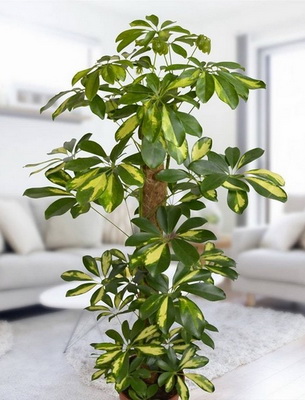

Today, quite often on the windowsills of houses and offices, you can find the home type of the sheffler flower. The external distinguishing characteristic of this plant will be the shape of its leaves. They resemble the spread fingers on a human hand.
The leaves of this flower are dissected, having from 4 to 12 lobules. And their shade can be solid green or with bright enough blotches, stains of yellow or white color.
It is noted that the plant almost never blooms at home. Inflorescences can often be seen in the botanical garden, as the conditions here are as close to natural as possible.
Indoor shefflers are similar in appearance to small trees or have the shape of a shrub. But at the same time, their shoots are quite thin, so it is recommended to attach large specimens to a support.
Look at the Scheffler houseplant in the photo and appreciate its beauty:

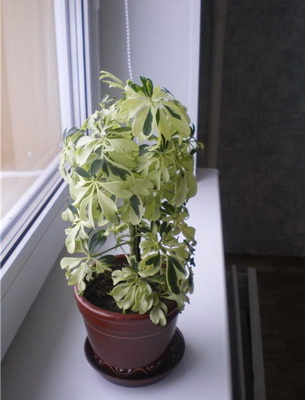
In leaving, this representative of the Aralievs is not whimsical. Even beginner growers can grow large, lush and beautiful specimens.
In nature, there are more than 200 species of this plant. But not every one of them has decorative features and characteristics. And only a few of them are considered domesticated.
For indoor breeding, shefflers are of the following types:
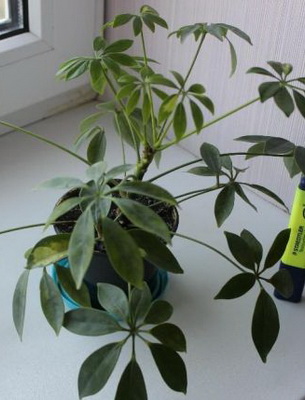
Radiant

Veitch
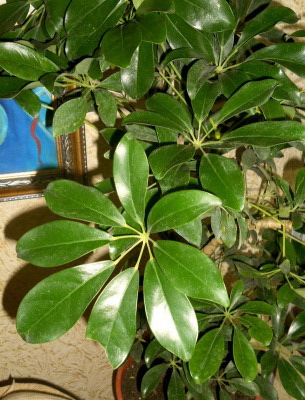
Eight-leaf

Tree-like
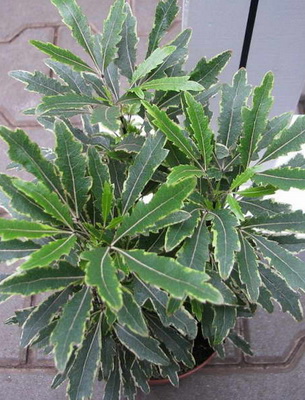
Graceful (finger)
Below is a description of each of them.
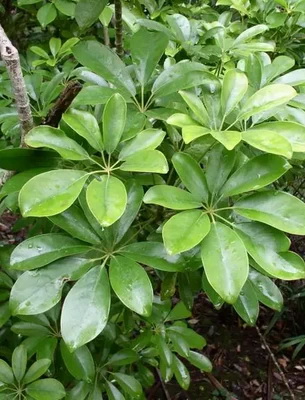
Radiant species (Schefflera actinophylla) - quite popular among flower growers, can also be called star-leaved. It is believed to be native to sunny Australia, where its relatives grow up to 12m in height.
The trunk of the domesticated plant is very powerful, at the base it is stiff, light gray in color. The leaves are arranged on long stalks of dark green with a reddish tint of color. The plate itself is divided on average into 15 parts, usually 14 or 16.
Each of them is oblong in shape with a pointed tip. The foliage is quite large, in diameter it can reach 20-24 cm. The shade of the halves of the plate is green, close to malachite, and their surface is waxed.
Look at the sheffler's room radiant type in the photo:
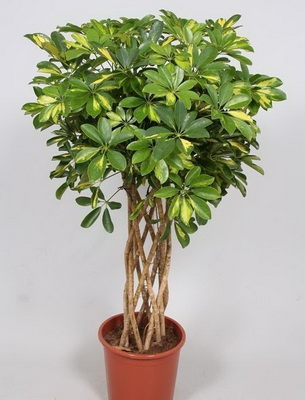
Some varieties of this type of sheffler may have a slightly different foliage color, for example:

"Green Gold" - mustard shade
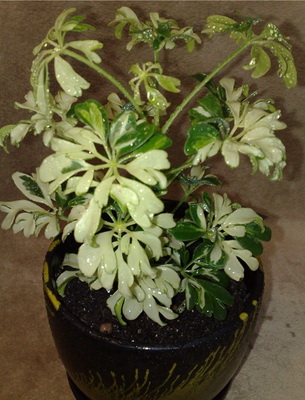
"Nova" - olive with yellowness.
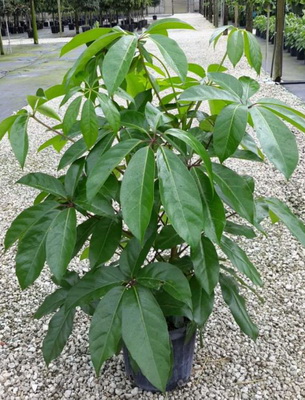
The eight-leafed tree (Schefflera octophylla) is popularly called the octopus tree.
It is characterized by rather long petioles of a light shade hanging down. They can hold up to 12 elongated sheets, pointed at the end. Each of them can be up to 40 cm in length.
Unlike radiant, this species, although it has glossy greenery, is rough to the touch. They are also characterized by distinct veins and a rich malachite hue that appears on an already grown leaf.But initially young greens of saturated bottle color with yellowness.
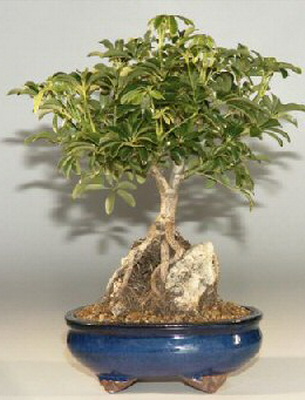
The species called "Veycha" is a sheffler, in which the leaf plate has an oval-elongated shape, with the edges of a wavy structure. It is reddish, and later changes to emerald.
Look at the tree-like Scheffler in the photo (Latin name - Schefflera arboricola):

This plant is believed to be native to New Guinea. At home, it grows into a small tree that has many shoots on an upright trunk. Also, this species gives a lot of basal processes. While the shoots are young, they are grassy, but over time they become darker and brownish in color.
There are such decorative coloring of the foliage of the shefflers, depending on the varieties of the variety:
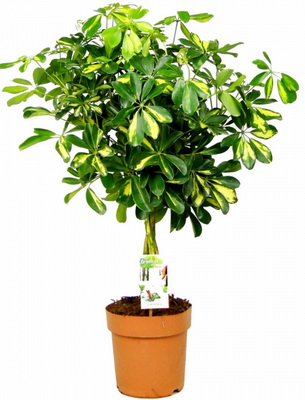
The Gold Capella is green with random yellow marks.
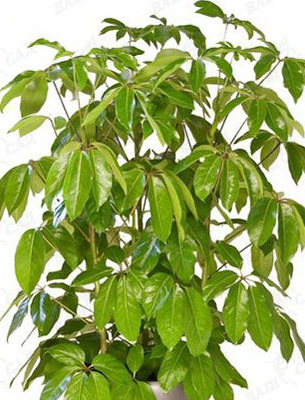
Amate is a bright malachite shade.
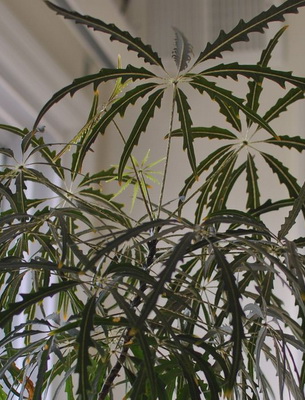
Schefflera elegant (finger aralia) —Schefflera elegantissima (formerly Dizygotheca) is an elegant plant that can grow up to 1.5 m in height.
From 7 to 11 narrow, long leaves are located, like fingers of a hand, on a thin stem. Look at the sheffler varieties of this species and its varieties.
The photo shows that the leaves of the young Schefflera elegantissima are reddish, then they turn dark green, and in the rarer species Schefflera veitchii, a white central vein appears on them with age:

Pests and diseases chiefs
Sheflera turns yellow
With improper or insufficient care, the chef is affected by scabbards, red spider mites and thrips. As a result of the vital activity of these insects, the plant loses its decorative effect: the leaves of the cheflera turn yellow, its growth slows down, and in the end it dies. To avoid the death of the plant from insects, regularly inspect the chefler, and when the first pests appear, remove them from the plant with a cloth or cotton swab dipped in soapy water. If you missed their appearance, and they have already occupied the plant, treat the chefler with a solution of Karbofos or Actellik (15-20 drops per 1 liter of water), just make sure that no chemicals get into the ground. With a very strong pest infestation, the treatment will have to be repeated after two weeks.
Yellow spots on the chefler appear from too bright light. Move the plant to the back of the room or shade it out of direct sunlight with a curtain.
Sheflera drops leaves
It happens that there are no pests on the plant, but, nevertheless, the shefler crumbles. Why does the shefler fall? The reason for the leaf fall in the shefler may lie in uncomfortable conditions for the plant. For example, if the room temperature is below 14 or above 30 ºC for a long time. Or in the case when its roots rot from chronic waterlogging.
How to save the boss from death in this case? It is necessary to remove it from the pot, carefully remove the rotten areas of the roots, then lower the roots of the chefler in the solution of Epin or Zircon, then treat them with Fitosporin or sprinkle with crushed coal, transplant into a fresh moist substrate and put a transparent plastic bag on the plant, sometimes removing it for ventilation and soil moistening. Finally, the package can be removed in 5-7 days
Sometimes the leaves of the sheflers fall due to insufficient lighting, variegated forms of the plant especially suffer from this.
Sheflera turns black
Often readers complain that the leaves of the chefs turn black, starting from the tips. This usually happens when the room humidity is low or due to poor watering. Correct these deficiencies in the care, and gradually the plant will regain its shape.
How to break up the chefler. The most famous ways.
Today, many experienced flower growers know everything about how this unpretentious and simple plant can be propagated. But for beginners in this business, our recommendations will be very useful. So, the main ways of breeding chefs at home are as follows:
- by propagation by cuttings;
- by germinating seeds;
- by means of reproduction by layering.
In addition, it is important to remember that without knowing the specifics care for the chefler's flower, none of these methods will give a complete guarantee of positive results

The simplest of them is the propagation of shefflers by cuttings. To do this, we recommend using semi-lignified cuttings, which are cut in the spring. Next, root the cuttings in water or take a substrate, for example, add sand (necessarily coarse-grained) to ordinary soil, follow the proportions 1: 1. Before this, the places where the cuttings are cut need to be treated with a special rooting stimulant in order to root them easier.
If you use water for rooting, when the roots appear and develop (the fastest in the chefler is of a solid green color, in the variegated one after 4 weeks), plant the cutting itself in the ground, cover with a bag, having previously made a hole for air to enter. But at the same time, do not forget to remove the bag every day 1-2 times, the plant should be ventilated for 20-30 minutes.
When rooting in the substrate, the bag should be put on immediately, and ventilated in the same way. Do not overmoisten the substrate, it should be kept slightly damp.
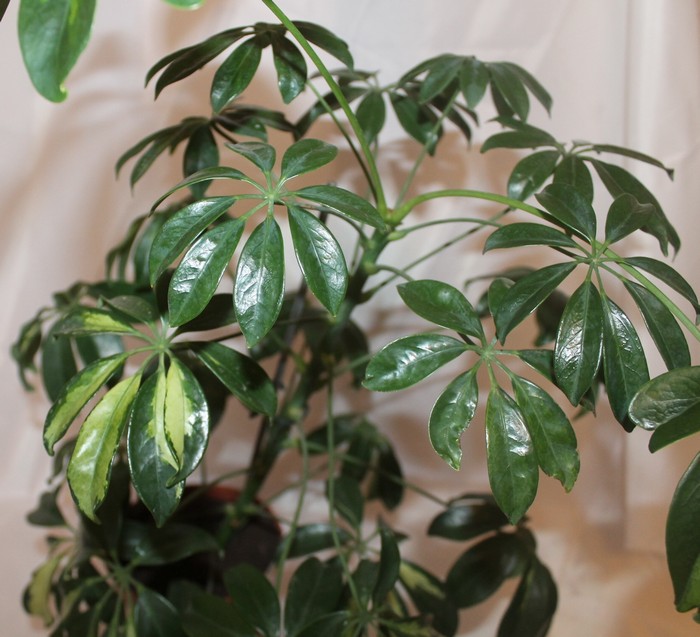
The second method is the reproduction of the chefler by germinating seeds. Unfortunately, the fruits of their seeds are not available for chefs at home. Therefore, purchased seeds are planted in winter, mainly in January-February, and in March. The soil must be loose, airy and moisture-permeable. There are two types of soil mix you can use that work well. Peat with sand or a handful of sand and a liter of earth is recommended. About half a centimeter, the seeds go deeper into the ground. Next, pour, cover with foil and place in a place with an acceptable temperature of 22-25 degrees Celsius. It is enough to air the flower once a day, while removing the film. The pot where the seeds were sown should have a drain and a hole to drain off excess water. When seedlings appear, the plant will require a lighter habitat. Create an air temperature between 15-17 degrees Celsius. When summer comes, do not forget to spray the babies, the chefs, not with cold, but with warm water.
It will be interesting to reproduce sheflers by layering, provided that there is a large version of this flower. When spring comes, cut the trunk of the plant
It is important to wrap the place of the incision with a layer of green moss, and then cover it with a layer of film. Moss must be moist
A month later, maybe a little later, the roots appear and then the stem can be cut off at the bottom of the new roots and planted in the soil made from mixtures of peat and sand 1: 1. When the chefs have new leaves, feel free to transplant it to its usual place.
Just a few simple rules and recommendations and the chef will happily greet you with his open palms!
Air temperature
The chefler needs to be kept at a temperature of + 22 ° C. As well as lighting, the temperature should be kept above zero all the time. There is no need to raise it, creating the tropics, but a comfortable home one will be fine. Problems begin when the chef freezes. Symptoms are especially pronounced if the plant is flooded or sprayed in a draft. It is better to reduce watering for a while, restoring it to the chefler. Follow the development of events.
Soil nutrients
Shefler is regularly fed. If there is not enough fertilizer, it turns yellow, starting from the lower leaves. other problems with the soil mixture, such as a too dense earthen lump, lack of loosening, transplanting has been carried out for a long time, etc. cause similar indicators. She also reacts badly to any interference in her calmness - she drops the leaves instantly, so they refuse to transplant for so long.
It is carried out by completely changing the substrate of the earth, but without removing the root clods, otherwise the small hairs are damaged.It is necessary to add "Epin" or "Zircon", also processing during the transplant process, in order to protect against unforeseen consequences. How to move the chefler so as not to damage it: transfer from one pot to another.
Watering chefs
The plant is watered moderately. In contrast to the brutal appetites for light and temperature, the plant prefers moderation in moisture. The result of frequent and unconditioned procedures can be yellowing of the foliage. Since the roots are hypersensitive, they quickly rot, then it takes longer and more difficult to restore it - it is better not to allow it.
Bad place
At the beginning of the article, we have already considered the main criteria for placing chefs in the house, which must be adhered to. Find a comfortable place for the plant with abundant lighting, warmth, without drafts and temperature changes. It is advisable that once again the leaves are not touched by the chefs, they are not cut off, the tree is not moved - they will also react extremely sharply to such tenderness of the chef. If the yellowing is caused by stress, watering with Epin is enough to calm the nervous plant.
Lack of moisture An insufficient amount of water in the soil is not so detrimental to the plant, but it also harms it. First of all, the decorative appearance suffers. Such specimens are weakened and more susceptible to disease. Their leaves begin to lose turgor, wither and fall off. Too dry air causes black spots on the leaves. In addition, in such conditions, the risk of the appearance of a spider mite, which loves dry air, increases. Therefore, you need to periodically spray the plant, and observe the watering regime. Top dressing An excess of mineral fertilizers, especially nitrogen, burns the root system. It begins to function poorly, and the foliage turns yellow. Lighting Each plant has its own light requirements. Some love places in a darker place, while others are not afraid of the burning spring rays of the sun. Sheflera belongs to the category of those who love well-lit places, but cannot tolerate exposure to sunlight. Direct rays can burn the flower and the leaves will turn yellow and lethargic. The lack of light does not cause such manifestations, but the pattern on the leaves will be practically invisible. Temperature The optimum temperature for the chefler is + 17-22 degrees. The plant does not tolerate an increase in temperature. The leaves lose their turgor and begin to wither. Pests and diseases Leaves can fall off due to the appearance of pests. But this happens, as a rule, already when there are a lot of pests and the plant is badly damaged. Most often, spider mites, aphids and scale insects can appear. Aphids and mites feed on plant sap and drain it. But at the same time, it is not always possible to notice pests immediately. The spider mite is very small and almost invisible. But its appearance can be recognized by a thin web entangling leaves and stems. Aphids are slightly larger in size, but insects live under the leaves, so they are also almost invisible. Pest control is best done with chemicals - insecticides. The sooner the treatment is carried out, the less the flower will suffer. In the absence of help, the cheflera can completely lose leaves, stop photosynthesizing and die.


